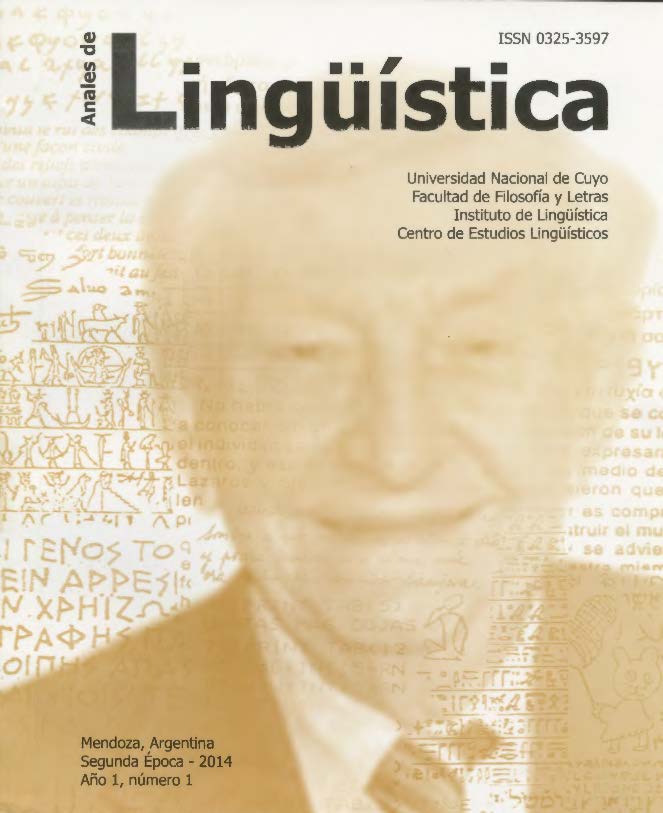Modulaciones del discurso en El biombo de Jorgelina Loubet
Keywords:
Speech, Modulations of the speech, Free indirect speech, Argentina Literature, Jorgelina LoubetAbstract
The narrative of Jorgelina loubet (Argentjne 1918-1997) presents an ample field for the analysis of the narrative speech in its different modalities. In the present work 1 propase to analyze the special discursive configuration of the text in relation with the narrative voice and the focalization. With this purpose, we circumscribe our analysis to the novel El biombo (1963) in which 1 operate the cJassification of the speech contributed by Beltrán Almeria (1992) who considers eighteen discursive varieties to express the voice or the thought in the impersonal narrative and in the personal. AJthough this classification is ample and detalled it has been insufficient for me at the time of approaching the detailed analysis of the alluded novel. Such fact has made me recognize a new modulation of free indirect speech that is not described by the alluded theoreticians, to which 1 have denominated indirect speech quasi free. This tenninology is inspired by the denomination that Graciela Reyes (1984) uses to talk about the free indirect speech: oratio quasi recta-. Denomination that the author uses to indicate the proximity of free indirect speech, with direct speech, -oratio recta.. in place of the possible identification that could be made of the free indirect speech, with indirect speech, guaranteed by the terminological similarity. In the same way, ín the case that 1 analyze - and adapting to me the terminology of Reyes (1984 )- 1 use the Latín adverb qua si in arder to a Ilude to a proper discursive modulation of the personal narrative that, being very near free indirect speech, it presents sorne conditions that make it different, as 1 will try to demonstrate.
References
Adam, J. y Ubaldina Lorda, C. (1999). Lingüística de los textos narrativos. Barcelona: Ariel.
Bajtin, M. (1989). Teoría y estética de la novela. Trabaos de lnvastigación. Trad. Helena S. Kriúkova y Vicente Cazcarra. Madrid: Taurus.
Bajtin, M. (1992). Estética de la creación verbal. 5° ed. Trad. Tatiana Bubnova. México: Siglo XXI.
Bal, M. (1985). Teoría de la Narrativa (Una introducción a la narratologla). Madrid: Cátedra.
Beltrán Almería, L. (1992). Palabras transparentes. La configuración del discurso del personaje en la novela. Madrid: Cátedra.
Domínguez de Rodríguez-Pasqués, P. (1975). El discurso indirecto libre en la novela argentina. Pontificia Universidade Católica do Rlo Grande do Sul. Instituto de Letras e Artes. Curso de Pós-Graduaçao em Lingüistica e Letras.
Genette, G. (1989). Figuras III. Trad. Canos Manzano. Barcelona: Lumen.
Loubet, J. (1963). El biombo. Buenos Aires: Losada.
Reis, C. (1989). Fundamentos y técnicas del análisis literario. Madrid: Gredos.
Reisz de Rivarola, S. (1987). Voces y conciencias modelizantes en el relato literario ficcional. En: T. Todorov y otros (1987). La crisis de la lilerariedad (pp.125-154). Madrid: Taurus.
Reyes, G (1984). Polifonía textual. La citación en el relato literario. Madrid. Gredos.
Tacca, O. (1978). Las voces de la novela. Madrid: Gredos.
Tacca, O. (1986). El estilo indirecto libre y las maneras de narrar. Buenos Aires: Kapelusz.
Downloads
Published
How to Cite
Issue
Section
License
Copyright (c) 2014 Autor
Esta obra está bajo una Licencia Creative Commons Atribución 2.5 Argentina.
Los/as autores/as que publican en esta revista están de acuerdo con los siguientes términos:
1. Los/as autores conservan los derechos de autor y garantizan a la revista el derecho de ser la primera publicación del trabajo bajo una licecncia Creative Commons Atribución 2.5 Argentina (CC BY 2.5 AR) . Por esto pueden compartir el trabajo con la referencia explícita de la publicación original en esta revista.
2. Anales de lingüística permite y anima a los autores a difundir la publicación realizada electrónicamente, a través de su enlace y/o de la versión postprint del archivo descargado de forma independiente.
3. Usted es libre de:
Compartir — copiar y redistribuir el material en cualquier medio o formato
Adaptar — remezclar, transformar y construir a partir del material para cualquier propósito, incluso comercialmente.












